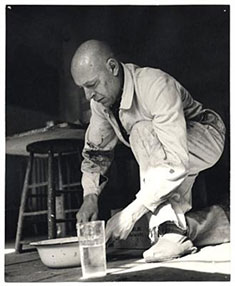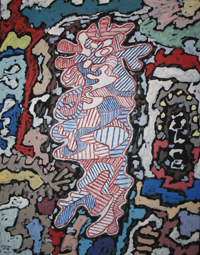| Jean Dubuffet | |
|---|---|
 |
|
| Born | July 31, 1901 Le Havre, France |
| Died | May 12, 1985 (at age 83) Paris, France |
| Nationality | French |
| Field | Painting, Sculpture |
| Works | View Complete Works |
Jean Dubuffet (1901-1985) was a French artist whose penchant for rebelling against the norms of society earned him almost as much notoriety as his art. Born in Le Havre, he learned rebellion as a small child. When he reached the age of 17, he left home and began his first endeavor to pursue a future in art, which lasted for only six months, as he became increasingly disillusioned with the art of the times. He decided to forego art and devote himself to running his father’s wine business. He was unable to completely abandon his painting entirely and, in the 1940’s, he finally succumbed to his love of art and returned to painting full-time.
Art Career
 Dubuffet could be viewed by some as one whose works were precursors to the pop art of the hippie era of the 1960’s. He expressed disdain for the mainstream art of his time, preferring to focus on the unusual, base, and unassuming styles of his art which would later be dubbed Art Brut, or Raw Art. He surrounded himself with artists who shared his views, and in 1944 he held his first show, which displayed his preference for subjects which represent the common, unassuming, and plain elements of life. In 1948, he joined with some of his colleagues to form the Art Brut Collection, which was heavily influenced by Dubuffet’s association with Dr. Hans Prinzhom, who became a mentor of sorts to Dubuffet. Through Dr. Prinzhom, Dubuffet became fascinated with the drawings made by children, as well as patients who lived in insane asylums.
Dubuffet could be viewed by some as one whose works were precursors to the pop art of the hippie era of the 1960’s. He expressed disdain for the mainstream art of his time, preferring to focus on the unusual, base, and unassuming styles of his art which would later be dubbed Art Brut, or Raw Art. He surrounded himself with artists who shared his views, and in 1944 he held his first show, which displayed his preference for subjects which represent the common, unassuming, and plain elements of life. In 1948, he joined with some of his colleagues to form the Art Brut Collection, which was heavily influenced by Dubuffet’s association with Dr. Hans Prinzhom, who became a mentor of sorts to Dubuffet. Through Dr. Prinzhom, Dubuffet became fascinated with the drawings made by children, as well as patients who lived in insane asylums.
In the 1960’s Dubuffet added sound, including music, to his art and also discovered his love for sculpting. Dubuffet remained true to his art and the philosophies which inspired it until his death in 1985.
Marriage
Dubuffet was married twice. He was initially married in 1925 to Paulette Bret, with whom he had a daughter and during this time he returned to the family wine business. But, this was short lived. They separated in 1933, and Dubuffet returned to his art when he discovered that to be engaged in business was too boring for his sensibilities.
In 1935, he married Emilie Carlu, who shared his passion for the arts. They opened their home to all manner of arts, including theater, music, poetry, and painting. Dubuffet frequently entertained by playing the accordion or bagpipes.
Artistic Style and Works
Dubuffet’s style reflected his preference for the plain and common, with a touch of the unusual. He believed that children and the insane were inherent artists whose drawings and designs bore more meaning than conventionally believed. Dubuffet disliked the mainstream of anything, preferring instead to examine new modes of thought, although his art forms were considered bazaar and were largely shunned by his contemporaries.
One of the most interesting techniques, for which Dubuffet became fascinated, was that of mixing substances such as sand, gravel, grass, and leaves with the thick oil paint that he preferred, to yield an interesting depth and texture to his paintings. Another interesting facet of Dubuffet’s paintings was his persistence in using plain, portrayals of people. These faceless beings were deliberate imitations of the matchstick-style people drawn by children and the mentally ill.
The Legacy of Dubuffet
Dubuffet’s foray into the unconventional paved the way for the artistic free thinkers of the 1960’s and 1970’s. Besides the unusual style of the paintings, the overall themes of focusing on the helpless, the downtrodden, and those who are in general scorned by society, were mirrored by the turmoil of the times.